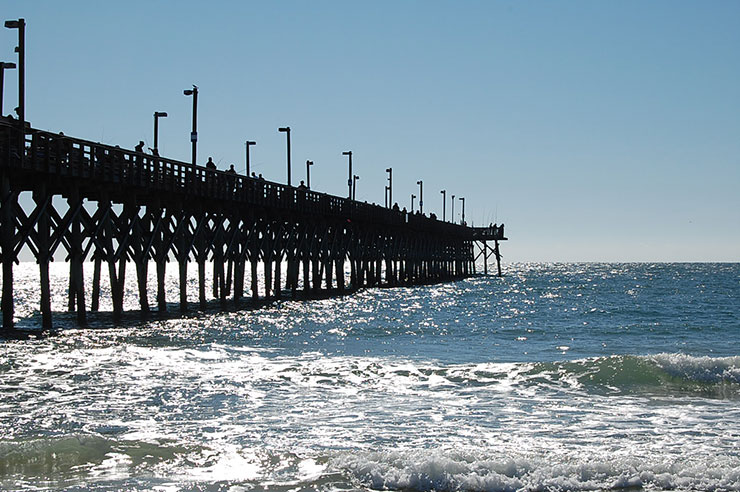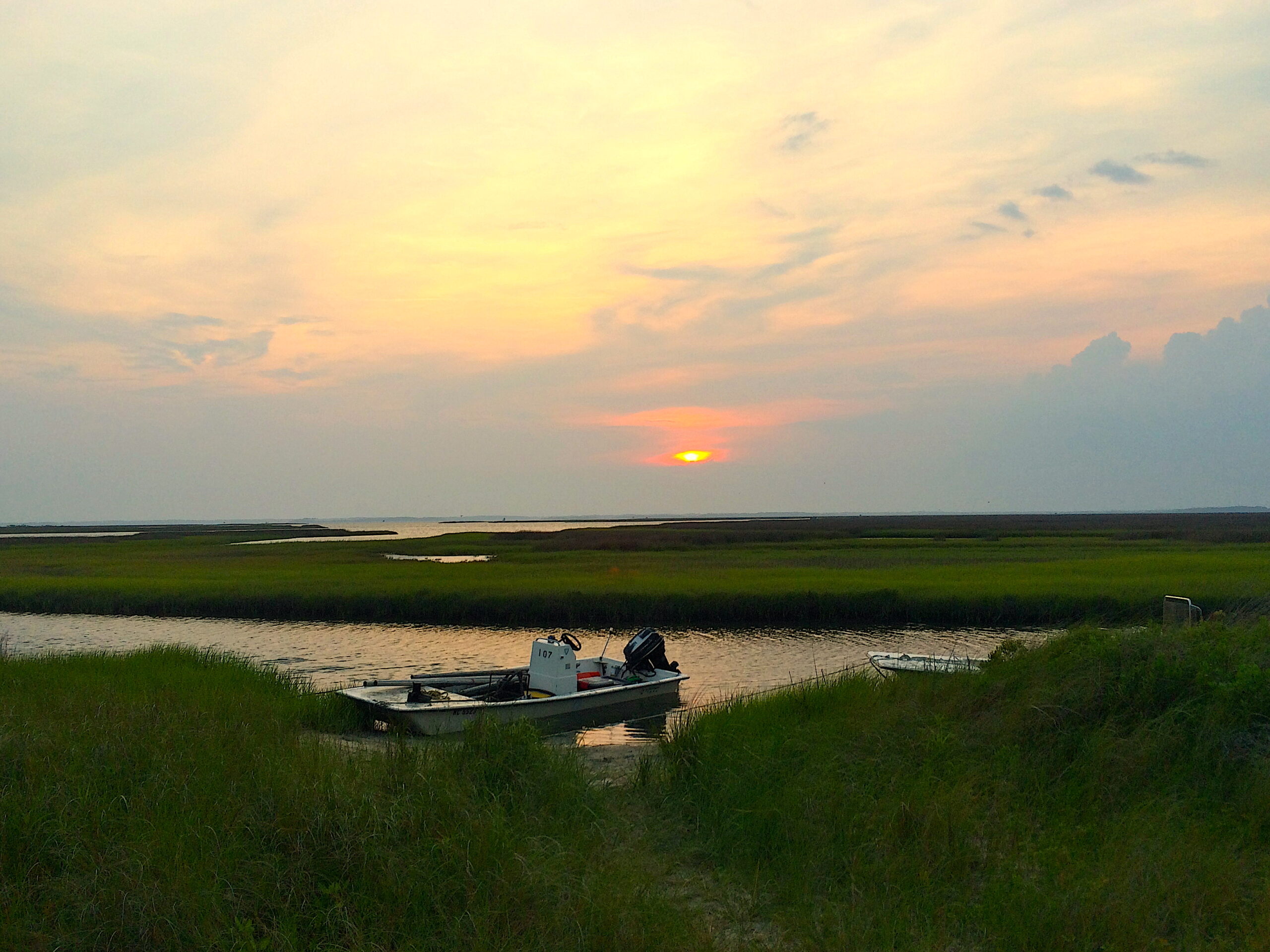Catherine McClellan and Danielle Waples have been going out in the dark to meet men they don’t know in places they’ve never been before. At least, that’s their joke about what they do.
Since September, McClellan, research specialist with the Duke University Marine Lab in Beaufort, and colleague Waples, have been meeting pound netters in the Pamlico Sound at unseemly hours hoping to find what many dread — sea turtles in fishing nets.
Usually, that kind of event puts net fishers at loggerheads with fisheries regulations, and sea turtles in danger of their lives. But in this case, the outcome can be fortunate for both.
That’s because McClellan is involved in finding ways to predict turtles’ movements to keep them out of fishing nets in the future. It’s research that joins prehistory with space-age technology as sea turtles — reptilian refugees from the age of the dinosaurs — are tagged with satellite transmitters.
It started with a grant awarded to commercial fisher Bill Foster of Hatteras, and Andy Read, marine scientist at the Duke lab.
“Such academic/fishing industry partnering is a hallmark of the N.C. Fishery Resource Grant program, which combines real-life fishery experience with scientific research,” says North Carolina Sea Grant Director Ronald G. Hodson.
The project is “a window into the lives and movements of sea turtles that we’ve never had before,” Read says.
“It’s very rare to be able to follow enough animals to be able to make sense of their movements,” explains Read. “Turtles are very idiosyncratic. If you look at only a small number of the animals, it may not be representative of all turtles.”
By the study’s end, 45 turtles will have been tagged. McClellan conducts the study with Waples as a regular field assistant.
When sea turtles interact with fishing nets, it’s normally a lose-lose proposition. Sea turtles caught in fishing gear drown if unable to surface for air. And when fisheries are implicated in turtle deaths, or when observed interactions exceed the limits established by the National Marine Fisheries Service (NMFS), fisheries can be shut down. The federal Endangered Species Act prohibits any “takes” of sea turtles by humans, McClellan says.
By tracking sea turtles’ movements, researchers hope to find ways to prevent deadly interactions between turtles and fishing gear.
In 1999, more than 70 dead turtles washed up along sound-side beaches of Ocracoke and Hatteras islands in a mass “stranding.” The N.C. Division of Marine Fisheries and NMFS determined that the large mesh (greater than five inches) flounder gillnet fishery was a likely cause, although no net marks were visible on the turtles, which appeared to be healthy prior to death.
Both agencies prepared an Incidental Take Permit as a way to keep the gillnet fishery open in the future. But the fishery was closed again in 2000 when limits for strandings and “incidental takes” were exceeded, says Jeff Gearhart, marine biologist with the DMF.
Shrimp trawls were active in the Pamlico when the strandings occurred, but they are equipped with turtle excluder devices, or TEDs, as required by law. TEDs propel turtles out of the trawl nets, says Gearhart. “The devices they use here have been tested by NMFS,” he explains. Tests must show that 97 percent of turtles entering a device are ejected out of it.
Yet the success of the devices is not entirely clear, according to Matthew Godfrey, coordinator for the state’s Sea Turtle Project of the N.C. Wildlife Resources Commission.
“Theoretically, mortality has dropped,” he says of the shrimp fishery. “But TEDs don’t always work. The same turtles can be caught several times a day, and that stress can cause death.”
The Sea Turtle Dilemma
Sea turtles, which coexisted with dinosaurs, are now in danger of going the way of them, according to McClellan.
All five species found in North Carolina waters — the green (Chelonia mydas), loggerhead (Caretta caretta), Kemp’s ridley (Lepidochelys kempii), leatherback (Dermochelys coriacea) and the Atlantic hawksbill (Eretmochelys i. imbricata) — are protected by law. All are classified as endangered except the loggerhead, which is considered threatened — and its status may change to endangered, as well.
The most common sea turtles in the state — and the ones included in the study — are the green, Kemp’s ridley and loggerhead.
Of the four families of sea turtles to emerge from the Cretaceous Period 65 to 70 million years ago, two families remain — the Dermochelyidae with its single member, the leatherback, and Cheloniidae, the hard-shelled sea turtles. All of them are now considered either endangered or threatened.
Meanwhile, some feel livelihoods are being threatened by regulations that protect turtles. Foster, who currently works under contract with NMFS on the Marine Mammal Take Reduction Team, says, “It would be difficult to find any commercial fisherman who believes there’s a shortage of turtles, just because they’re getting more and more of them.”
“Most fishermen have nothing against turtles,” says Foster, “but sometimes it’s hard for them to see the justification” for closures.
“Sometimes it doesn’t make sense why they close one area when they know there are turtles in other areas, too,” Foster explains.
Godfrey says it is possible that there are more strandings reported because there are more turtles. “The increases can also be due to more people looking,” he says.
Evidence linking the 1999 mass stranding to the flounder fishery was circumstantial. But, says Godfrey, “the fishery started up and within a week there was a huge stranding event. That’s pretty good evidence.”
Gearhart speaks of the difficulties of accurate population assessments. “Anecdotally, from what people on the water are telling me, they’re seeing more. It makes sense, because we’re protecting them,” he says.
“It’s a real ‘Catch 22’ for our fishermen. The more we protect, the more there are. And the more there are, the more will be caught,” says Gearhart.
Total strandings for 1999 were 605 turtles. In 2000, the number rose to 888 and dropped to 361 for 2001, according to data supplied by Godfrey.
Numbers of turtle strandings fluctuate each year, Godfrey says. But, he adds, “Whether there are 500 or 800, they’re all too high.”
McClellan agrees. Regardless of what the actual population of sea turtles is, she explains, it is unlikely that losses that high can be sustained without irreparable harm.
In the Field, On the Water
For McClellan, a typical day of fieldwork begins the night before when she calls pound net license holders to ask if they will be going out the next day and if she can accompany them.
A frequent response is “hesitation,” she says.
It can take many attempts to coordinate fishing trips with research. From calls to nearly 50 fishers, the team has gone out with fewer than 10 — but McClellan says the research team has accompanied some boats multiple times.
It’s a go on a particular fall evening when Howard Gaskill, commercial fisher and ferry worker, agrees to allow the researchers to follow him and his brother, Kenneth, to their pound nets the next morning.
The study is designed to coincide with the flounder gill net fishery, says McClellan, but pound nets, which impound turtles while allowing them to surface for air, are more likely to yield turtles alive and in condition suitable for tagging.
At the Duke lab, the research vessel Proteus is hitched to a truck and ready to go by 5:30 a.m. Fishers won’t likely wait for tardy researchers.
There is, perhaps, an ominous feel to the cool, drizzly darkness, but to Waples and McClellan, it seems to be just another day in the field. Later, when the water is choppy and the drizzle gives way to intermittent rain, the two will keep queasiness at bay with Goldfish — crackers, that is. Preparedness pays.
Out past a spoil island — a byproduct of dredging — near where the Pamlico gives way to Core Sound, the Gaskills reach the first net. Howard yells, “We’ve got a turtle.”
McClellan wrestles the loggerhead, which appears to be at least half her own weight, aboard the Proteus. The turtle goes into a circular, foam-lined blue tub, and McClellan begins her assessment with Waples recording data.
The researchers pronounce the turtle a “virgin,” bearing no preexisting tags. McClellan confirms this by scanning the turtle with a Starship Enterprise-type device. The scanner would detect implanted PIT tags, or passive integrated transponders, which carry identification from previous encounters with researchers.
To the uninitiated, the creature in the tub is — wow — a sea turtle. McClellan sees more. It’s not moving enough, and it has so many barnacles, that McClellan suspects it has been lethargic for some time. She describes it as skinny and pale.
This turtle will not be tracked by satellite, will not sport a $2,000 transmitter. McClellan confers with Godfrey, who personally will deliver the lethargic loggerhead to the Karen Beasley Sea Turtle Rescue and Rehabilitation Center at Topsail Beach.
But first, while still on board the Proteus, McClellan follows a NMFS protocol, including placing a PIT in a front flipper, and metal tags on both rear flippers.
McClellan makes measurements and a biopsy is taken from a flipper for genetic studies. A blood sample from the turtle’s neck will determine its sex.
There is no sure way to tell a juvenile turtle’s sex by looking at it, McClellan explains, but she gives a large-ballpark figure for its age. “Little turtles stay in the ocean until between 10 and 14 years old,” before returning to the sound. This one’s age is probably between 14 and 30, she says.
Loggerheads lay eggs on North Carolina beaches. When discovered, nests are watched over by volunteers with the N.C. Turtle Project. Hatchlings find their way to the ocean and navigate using cues such as “celestial bodies (i.e., light) silhouettes, waves and currents, and magnetic fields,” McClellan explains.
“The babies go out to the Gulf Stream for an undetermined period of time,” says McClellan.
But where specifically they go — and what they do there — evokes what is a common answer to many questions about sea turtle migration.
“We don’t know,” McClellan says. “They’re called the lost years. Nobody knows for sure where they go or how far they go.”
No one knows why so many turtles interact with flounder gill nets, but McClellan hopes to find out.
“It is likely that temperature is causing both turtles and flounder to be migrating that time of year. It could be they’re both migrating out of the estuary.”
“They may just go offshore, south, or to the Gulf Stream,” McClellan explains. “There is evidence that an individual will come back to the same area each year.”
Understanding turtle migration is key to making regulations that are more specific and protect both turtles and fisheries.
But why spend so much energy protecting sea turtles when, in an economically depressed part of the state, people’s livelihoods can be at stake?
There are issues of biodiversity and “ecosystem function,” McClellan notes.
“We don’t know enough about how (sea turtles) are using the habitat and what it would look like without them,” she adds.
“Certainly everyone has different opinions, and so we resort to thinking about ‘viable population sizes,’ ” McClellan says.
Ultimately, the problem of accidental takes of sea turtles in fisheries might be too complex for numerical equations.
“Accidents happen, and, when turtles and fishers use the same area for different purposes, there are bound to be interactions,” McClellan adds.
“But we need to be responsible in understanding and controlling these interactions, and that’s what I think this project and the efforts of NMFS and DMF, the Wildlife Resources Commission and, indeed, some of the fishermen are trying to do.”
This article was published in the Winter 2003 issue of Coastwatch.
For contact information and reprint requests, visit ncseagrant.ncsu.edu/coastwatch/contact/.
- Categories:



